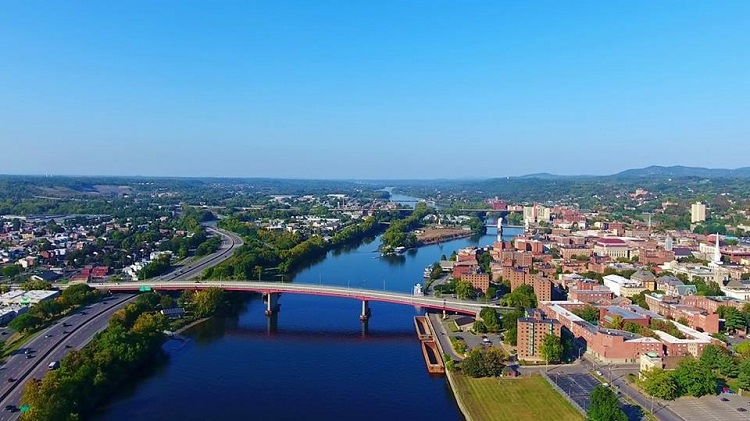An Option for a Montreal – New York City River Cruise
It is presently possible for small private watercraft to sail between the shorter and more direct inland waterway route from New York City to the Lower Saint Lawrence River east of Montreal. However, a large commercial river cruise vessel carrying tourists could sail into the southern region of Canada’s Richelieu River and as far as the quaint Quebec town of Saint-Jean-sur-Richelieu, located some 25 miles (40 kilometers) from Montreal.
Introduction
Following the demise of trans-oceanic passenger ship services that lost market share to the airlines, a small number of maritime managers adapted the last commercial ocean-going passenger transportation ships to cruise and tour services. The service proved popular, and ocean tour and cruise operations have developed into a thriving and vibrant industry. Prior to the demise of ocean passenger ships, there was a time when river passenger vessels proved popular along major navigable inland waterways including into the era of the passenger trains. River vessels sailing overnight schedules offered more comfortable, cost competitive service on between several pairs of cities.
Competition from the combination of railway services, inter-city bus services and competitively priced airline service resulted in the closure of overnight river transportation services carrying passengers. Tour operators tested the market for multi-day cruises along inland waterways, with the result that such cruises are available along several inland waterways across Europe along the Danube River, Asia along the Yangtze River and even North America along the Mississippi, Ohio and Saint Lawrence Rivers. Small river cruise vessels carry 40 to 90 guests on multi-day tours along such waterways as the Erie Canal and Rideau Canal.

Green Island Bridge with Starbuck Island in background
New York City – Montreal Cruise
At present, Great Lakes Cruises operates 88 passenger vessels that sail north along the Hudson River from New York City to the Erie Canal and then to the Oswego Canal into Lake Ontario. The vessels than sail north along the windswept eastern region of Lake Ontario to the Saint Lawrence River, then eastbound to quayside at Montreal. An alternative route would sail from New York City north along the Hudson River and continue north to the Champlain Canal, where a series of locks connects to Lake Champlain that flows into the Richelieu River that flows to the Lower Saint Lawrence River.
The 88-passenger cruise vessel could sail along the Hudson River through to Lake Champlain and into the Richelieu River as far as the central area of the town of Saint-Jean-sur-Richelieu that is located some 25 miles southeast of Montreal. While the voyage would be extremely scenic between New York City and Saint-Jean-sur-Richelieu, a tour bus would be required to ferry passengers to and from Montreal. A 12-mile canal with nine navigation locks bypasses a non-navigable section of river and can transit vessels of up to 100 feet length by 21 feet width by six feet draft.
Mini-Cruise Vessel
A mini-cruise vessel built with a draft of six feet, beam of 21 feet and length of 112 feet with lift-up bow would be narrower than the mini-cruise vessel that carries tourists along the Rideau Canal. A multi-day cruise aboard a mini-cruise vessel would need to involve multiple stops to provide passengers with pre-prepared meals that would be delivered to the vessel, or passengers would disembark to take meals at nearby restaurants. Some stops could be overnight stops to allow for passenger accommodation at waterfront or nearby hotels. The cruise vessel would operate like a long-distance bus tour.
Borrowing from the precedent of the barge industry, there would be scope to develop an extended-length, coupled two-section version of the mini-cruise vessel that would sail between New York City and Saint-Jean-sur-Richelieu. It would be uncoupled and operate in two sections through the navigation locks along the Chambly Canal, to sail as a coupled assembly north of the canal to the Saint Lawrence River. The addition space aboard a two-section coupled vessel could enhance accommodations for a possible compliment of 50 passengers. Tour planners would need to evaluate market prospects for a mini-cruise vessel sailing between New York and Montreal.
Lengthening Navigation Locks
Extending the length of navigation locks may be a long-term possibility if sufficient commercial tourist traffic materializes on the New York City – Montreal river cruise via Lake Champlain. While the Lower Ottawa River only involves two navigation locks, there are nine navigation locks in the Saint-Jean-sur-Richelieu region and lengthening each of those locks will involve much greater expense.
River Port Development
The prospect of operating multi-day river cruises via Lake Champlain between New York and Saint-Jean-sur-Richelieu would require the development of a suitable dock area where a vessel of up to 300 feet in length by 43 feet width may be berthed.
Change of Vessels
Coordination of schedules and maintenance involving two vessels would be required to offer river interlined cruise services between Montreal and New York City. Such a service would include extended sailing to Quebec City and Ottawa, especially if Canadian authorities were willing to lengthen navigation locks along the Lower Ottawa River between Montreal and Ottawa. An international vessel would sail between New York City and the southern entrance to the Chambly Canal at Saint-Jean-sur-Richelieu while a Canadian vessel would sail to/from Saint-Jean-sur-Richelieu connecting to Quebec City, Montreal and Ottawa. Cruises would include a one-night hotel accommodation at Saint-Jean.
During a scheduled overnight layover, accommodations aboard both vessels would be cleaned and prepared for new customers. One group of customers would be traveling to Canada while another group would be returning to New York. Alternatively, Canadian customers sailing south may board a prepared vessel at Saint-Jean-sur-Richelieu, for a multi-day return cruise to/from New York City while customers from New York City area sail on an eastern Canadian inland waterway cruise. Vessels 300 feet long and 43 feet wide could sail New York City – Saint Jean, with vessels 35 feet wide sailing north of Saint-Jean.

Collar City Bridge reaching downtown Troy
Tour Service Interlining
The close proximity between Montreal and Saint-Jean-sur-Richelieu allows for possible interlining between multi-day cruises based at Montreal, with multi-day cruises that sail via Lake Champlain between New York City and the Richelieu River. If Canadian authorities were willing to lengthen the pair of locks along the Ottawa River, multi-day river cruise excursions could sail the Ottawa – Montreal – Quebec City route. Some multi-day river cruises could originate at Saint-Jean-sur-Richelieu to carry tourists south to New York City and back, or south to Albany and west toward Niagara Falls.
A circular river cruise could involve two vessels sailing from New York City, departing several days apart. The first vessel would sail to the Erie Canal to Lake Ontario, then to the Saint Lawrence River and to Montreal and Quebec City. On its return voyage, it would sail to Saint-Jean-sur-Richelieu where a northbound vessel from New York City would arrive. The vessels would be serviced to switch passengers, with the passengers who arrived from New York City then sailing to Quebec City and the passengers who arrived from Quebec City, would sail south to New York City via Lake Champlain.
Conclusions
While a large passenger cruise vessel sailing via inland waterway from New York City north via Lake Champlain cannot sail into the Lower Saint Lawrence River, it can sail within 25 miles of Montreal, perhaps sufficiently close that tourists might find a 40-minute bus ride quite acceptable.
For tourists seeking to sail via inland waterway from Canada aboard a large river vessel, the close proximity between Montreal and Saint-Jean-sur-Richelieu could make that town an acceptable location from where tourists might begin and end their river cruises.
There may actually be a market for a multi-day river cruise between New York City and Montreal, involving a mini-cruise vessel or a two-section coupled version of such a vessel capable of fitting into the navigation locks on the north side of Saint-Jean-sur-Richelieu.
The opinions expressed herein are the author's and not necessarily those of The Maritime Executive.
